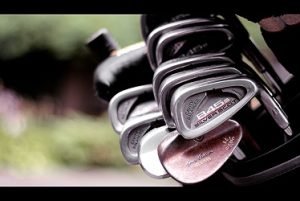Compressing a golf ball with irons is an essential skill for golfers looking to maximize their distance and control. Compressing the ball is about generating enough force and spin to get the ball to fly far and straight. Here are some tips on how to compress a golf ball with irons:
- Choose the right iron – Choose an iron that suits your swing speed and skill level. A 7 or 8 iron is a good choice for most golfers, as they provide a good balance of loft and control.
- Position the ball correctly – Position the ball in the center of your stance, or slightly towards your leading foot. This will help you make solid contact with the ball.
- Take a balanced stance – Make sure your feet are shoulder-width apart, and your weight is evenly distributed between both feet. This will help you maintain your balance throughout the swing.
- Keep your hands ahead of the ball – Keep your hands slightly ahead of the ball at impact, which will help you compress the ball and generate more spin.
- Swing down and through the ball – Make a smooth, controlled swing, and focus on hitting down on the ball, rather than trying to lift it into the air. This will help you compress the ball and generate more backspin.
- Follow through – After you make contact with the ball, continue your swing through to a full finish. This will help you maintain your balance and generate more power.
- Practice – Compressing a golf ball with irons takes practice, so don’t be discouraged if it takes some time to master. Focus on making solid contact with the ball and gradually increasing your swing speed and power.
- Use your body – Don’t just rely on your arms and hands to generate power. Use your entire body to create a smooth, powerful swing. This means turning your shoulders and hips as you swing through the ball.
- Keep your head still – It’s important to keep your head still throughout the swing, as any excessive movement can affect your balance and timing.
- Use the right clubface angle – The angle of the clubface at impact is crucial for compressing the ball. Make sure the clubface is square to the ball at impact, and slightly delofted to increase the compression.
- Hit the ball first – To compress the ball, you need to hit it first, before making contact with the ground. This means taking a divot after the ball, rather than before it.
- Adjust for wind and slope – When hitting into the wind or on a slope, you may need to adjust your stance and swing to account for the added resistance.
- Pay attention to ball position – The position of the ball in your stance can affect how you compress it. Experiment with different ball positions to find the one that works best for you.
- Visualize the shot – Before you swing, visualize the shot you want to hit. This will help you focus on your target and make a more confident swing.
Iron Selection Based on Ball Compression
| Iron Number | Recommended Ball Compression | Recommended Loft Angle | Recommended Swing Speed | Recommended Swing Path |
|---|---|---|---|---|
| 3 | 70-80 | 20-23 degrees | 75-85 mph | Slightly descending |
| 4 | 70-80 | 20-23 degrees | 75-85 mph | Slightly descending |
| 5 | 70-80 | 24-27 degrees | 70-80 mph | Slightly descending |
| 6 | 70-80 | 24-27 degrees | 70-80 mph | Slightly descending |
| 7 | 80-90 | 28-31 degrees | 65-75 mph | Slightly descending |
| 8 | 80-90 | 28-31 degrees | 65-75 mph | Slightly descending |
| 9 | 90-100 | 32-35 degrees | 60-70 mph | Slightly descending |
| PW | 90-100 | 36-39 degrees | 55-65 mph | Slightly descending |
| GW | 90-100 | 40-43 degrees | 50-60 mph | Slightly descending |
| SW | 90-100 | 54-58 degrees | 40-50 mph | Slightly descending |
Proper Setup for Compressing a Golf Ball with Irons
| Setup Component | Proper Technique |
|---|---|
| Grip | Hold the club with a light grip pressure to promote a smooth swing. |
| Stance | Position your feet shoulder-width apart with your toes slightly flared out. Align the ball with the center of your stance. |
| Ball Position | Place the ball slightly ahead of the center of your stance. |
| Posture | Bend your knees slightly and hinge forward from your hips, keeping your spine straight. Keep your weight balanced on the balls of your feet. |
| Alignment | Align your body parallel to your target line. |
Club Selection for Compressing Golf Balls
| Iron | Loft (degrees) | Recommended Ball Compression | Swing Speed (mph) | Distance (yards) |
|---|---|---|---|---|
| 3 | 20-22 | Low compression | 80-90 | 170-190 |
| 4 | 23-25 | Low to medium compression | 80-90 | 160-180 |
| 5 | 26-28 | Medium compression | 80-90 | 150-170 |
| 6 | 29-32 | Medium to high compression | 80-90 | 140-160 |
| 7 | 33-36 | High compression | 80-90 | 130-150 |
Techniques for Compressing Golf Balls
| Technique | Description |
|---|---|
| Ball position | Place the ball slightly ahead of center in your stance. |
| Weight transfer | Shift your weight to your front foot during the downswing. |
| Shaft lean | Lean the club shaft slightly towards the target at impact. |
| Divot pattern | Take a divot after striking the ball to indicate compression. |
| Follow-through | Maintain a full follow-through to ensure solid contact. |
Factors Affecting Golf Ball Compression
| Factor | Description |
|---|---|
| Clubhead speed | A higher Clubhead speed creates more compression. |
| Ball compression | Low compression balls are easier to compress than high compression balls. |
| Clubhead design | Clubs with larger sweet spots are easier to compress the ball with. |
| Swing plane | A steeper Swing plane can create more compression. |
| Turf conditions | Firm turf conditions allow for more compression than soft conditions. |


